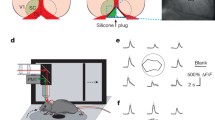Abstract
The visual field of the pigeon, like that of many birds, is largely monocular and panoramic. Only a limited portion of the field immediately in front of and below the beak is binocular (Martinoya et al., 1981). This binocular portion of the field corresponds to a region in the upper temporal quadrant of the retina — the so-called red area or red field — where many of the cones contain red oil droplets. The red area has a relatively high tectal magnification factor and a ganglion cell density comparable to that of the central fovea in the monocular field (Binggeli and Paule, 1969; Clarke and Whitteridge, 1976; Galifret, 1968; Nye, 1973; Whitteridge, 1965; Yazulla, 1974), all of which suggest an area specialized for acute vision comparable to the fovea itself. The near-point of accommodation for this portion of the field, however, has been found to be much closer than that of the lateral fields (Nye, 1973). In short, there appear to be two areas of specialization within the pigeon retina: (i) a central fovea for viewing distant objects within the monocular field, and (ii) another area of acute binocular vision in the red area for viewing stimuli located only a few centimeters away from the beak.
Access this chapter
Tax calculation will be finalised at checkout
Purchases are for personal use only
Preview
Unable to display preview. Download preview PDF.
Similar content being viewed by others
References
Binggeli, R.L., and Paule, W.J., 1969, The pigeon retina: Quantitative aspects of the optic nerve and ganglion cell layer. J. Comp. Neurol., 137:1–18.
Clarke, P.G.H., and Whitteridge, D., 1976, The projection of the retina, including the “red area”, on to the optic tectum of the pigeon. Quart. J. Exp. Physiol., 61:351–358.
Galifret, Y., 1968, Les diverses aires fonctionelles de la retine du pigeon. Z. Zellforsch., 86:535–545.
Goodale, M.A., and Graves, J.A., 1982, Interocular transfer in the pigeon: Retinal locus as a factor, in “Analysis of Visual Behavior”, D. Ingle, M.A. Goodale and R. Mansfield, eds., M.I.T. Press, Cambridge.
Graves, J.A., and Goodale, M.A., 1979, Do training conditions affect interocular transfer in the pigeon? in “Structure and Function of the Cerebral Commissures”, I. Steele-Russell, M.van Hof, and G. Berlucchi, eds., Macmillan, London.
Hodos, W., Leibowitz, R., and Bonbright, J.C., 1976, Near-field visual acuity of pigeons: Effects of head location and stimulus luminance. J. Exp. Anal. Behav., 25:129–141.
Jenkins, H.M., and Moore, B.R., 1973, The form of autoshaped response with food or water reinforcers. J. Exp. Anal. Behav., 20:163–181.
Jenkins, H.M., and Sainsbury, R.S., 1970, Discrimination learning with the distinctive feature on positive or negative trials, in “Attention: Contemporary Theory and Analysis”, D.I. Mostofsky, ed., Appleton-Century-Crofts, New York.
Martinoya, C., Rey, J., and Bloch, S., 1981, Limits of the pigeon’s binocular field and direction for best binocular viewing. Vis. Res., 21:1197–1200.
Nye, P.W., 1973, On the functional differences between frontal and lateral visual fields of the pigeon. Vis. Res., 13:559–574.
Whitteridge, D., 1965, Geometrical relations between the retina and the visual cortex, in “Mathematics and Computer Science in Biology and Medicine”, Medical Research Council, London.
Wolin, B.R., 1948, Difference in manner of pecking a key between pigeons reinforced with food and water, Note No. 4, Conference on the Experimental Analysis of Behaviour, 1948, Reprinted in “Contemporary Research in Operant Behavior”, A.C. Catania, ed., Scott, Foresman, New York.
Yazulla, S., 1974, Intraretinal differentiation in the synaptic organization of the inner plexiform layer of the pigeon retina. J. Comp. Neurol., 153:309–324.
Author information
Authors and Affiliations
Editor information
Editors and Affiliations
Rights and permissions
Copyright information
© 1983 Plenum Press, New York
About this chapter
Cite this chapter
Goodale, M.A. (1983). Visuomotor Organization of Pecking in the Pigeon. In: Ewert, JP., Capranica, R.R., Ingle, D.J. (eds) Advances in Vertebrate Neuroethology. NATO Advanced Science Institutes Series, vol 56. Springer, Boston, MA. https://doi.org/10.1007/978-1-4684-4412-4_17
Download citation
DOI: https://doi.org/10.1007/978-1-4684-4412-4_17
Publisher Name: Springer, Boston, MA
Print ISBN: 978-1-4684-4414-8
Online ISBN: 978-1-4684-4412-4
eBook Packages: Springer Book Archive




